
Print-on-demand is a business that requires the least investment, can be started right off, and you don’t need to manufacture or store goods!
Sounds like a fantasy? But it isn’t…
In fact, a print-on-demand business is a lifestyle of many individuals. Some people treat it as a side hustle, and some as passive income; for some, it’s their primary business. Anyhow, people are making a living with print-on-demand businesses.
In this article, we will be discussing how to start making money online with print-on-demand business. But let us first see what it is print-on-demand.
What is Print-on-Demand (POD) and How Does It Work?
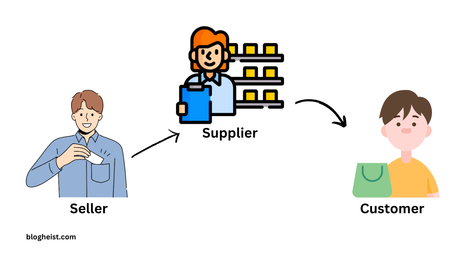
In print-on-demand business, there are three parties involved.
- Seller: One who is selling the product on his or her website.
- Supplier: A person who will supply the product if a customer orders.
- Customer: Who is ordering the product.
You (the seller) will provide the prints, and the supplier will print the product and ship it to the customer. You will collect payment, and the supplier will be responsible for shipping to the provided address.
But how does this work?
Let’s say you started a t-shirt printing business in the cricket niche. That means you will only print t-shirts related to cricket sport. Now, you will create a website and add your prints.
- You have used Shopify – an eCommerce website builder, to create a website.
- For creating photos of t-shirt prints, you have used Canva – An online photo editing tool.
Next step, you need to find a supplier who will print your designs and ship them to the customer.
- To find the supplier, you go to Printify, compare the rates, and choose the best supplier.

After you have done some marketing on social media, your friend John ordered a t-shirt from your website. He provided his address on your website and selected a credit card as a payment method.
Once the order is placed, your payment collector (e.g., Razorpay) has collected the payment, and your supplier has printed the product with your design and shipped it to a given address.
The money will be directly transferred to your bank account.
That’s how simple it is.
Pros and Cons of Print-on-demand

Until now, you have pictured POD as the easiest business, but let’s look at the whole picture.
Pros
- Low Capital Investment: The two significant costs involved in POD are Website building and marketing. Initially, you market your business using free social media; you only have to invest in website building.
- No Need for Physical Space: Stocking, warehousing, or manufacturing require a lot of space, but with a Print-on-demand business, you just need a small table for your laptop.
- Lowest Risk: If we consider the worst-case scenario, which is zero sales. Then, too, we haven’t made a loss of thousands of dollars.
- Easy Experimentation: You can easily experiment with multiple designs and see which makes more sales.
- Ability to Scale: If your designs are good and you are making sales, you can further sell your products on Amazon like an e-commerce platform or in the offline market.
Cons
- Low-Profit Margin: There are too many costs involved in print-on-demand business. Website management cost + shipment cost + supplier’s cost & profit + marketing cost, which makes it harder to get high-profit margins.
- Return policy: Make sure your return policy aligns with the supplier’s return policy.
- Free Entry: The market is free for everyone, that’s why there are high chances of competition as there is almost no entry barrier.
- No Control over the Product: You have limited customization options; you can’t fully customize the product.
These were some of the challenges you might face starting a print-on-demand business.
How to Start Making Money Online with Print-on-Demand Business
By now, you have known how print-on-demand business works and its pros and cons. Now, we will see step-by-step how to start making money online with print-on-demand business.
Remember that the ultimate goal of any print-on-demand business is to make profitable sales.
1. Decide What You Are Going to Sell
In short, what is your niche and your target audience?
Most businesses fail because they can’t define their niche and target audience. You need to be very specific for your niche audience.
For example –
- Wrong – I will sell t-shirts
- Niche down – I will sell t-shirts to college-going girls
The first statement was too broad; thousands of businesses are selling t-shirts. But when you niche down to college-going girls, competition reduces, and you will find that only 30 – 40 businesses are selling t-shirts for college-going girls.
Your marketing cost and product designing efforts were highly reduced by this.
Devotee some time to plan your niche, target audience, and product you will sell.
2. Launch Your E-commerce Store
The first step is planning, and the second step is executing.
Now it’s the time to get your prints ready.
- You can design on your own using Photoshop or Canva.
- Or, you can hire a graphic designer from Upwork and Fiverr-like marketplace.
- You can use the free stock images site (like Freepik) to get royalty-free images.
- And you can also buy the designs from sites like DesignPickle and DesignerCash.
You need an e-commerce store to showcase these designs if you have created a website before. Cool, it’s an easy game for you.
But even if you haven’t, don’t worry. You can create a good e-commerce website using helpful tools.
Here is a step-by-step guide.
How to Create an E-commerce Website
It’s worth investing some time in creating a good website; typically, you will require 2-3 days to create a good e-commerce website.
Learn the concepts 👩🏫
Domain – It is a unique internet address of a website, for example – facebook.com; one can buy such a domain and create a website on that address.
Plugins – Plugins are third-party services you can add to your website; for example, if you want to receive payment on your website, you can add a payment plugin. Plugins can be both paid and free.
Hosting – Every website you visit is hosted on a server. In simple words, you need a hosting server to make your website live. There are many hosting companies that can host your website.
- Domain Registration – Firstly, buy a domain name related to your business. You can use the following services to buy and register your domain name – Namecheap, Hostinger, GoDaddy, etc.
- E-commerce Platform – Now, to host your domain, we need an e-commerce platform. Here are some of the recommended e-commerce platforms:
- Shopify
- WordPress + WooCommerce
- Etsy
- Design Your Website – A simple and easy way to design your website is to use a pre-available template. Then, create five basic pages: Homepage, contact, about, payment, and shipping information.) Watch this YouTube video to learn how to design your e-commerce website.
- Add Partner’s Dropshipping Plugin – Now, choose your print provider and install its plugin.
3. Add Products in Your Store
Now, it’s time to create your website into a store.
For this, you need to install the print provider’s plugin.
- Use the Shopify Sourcing app
- WooCommerce + Dropshipping extension
- Etsy print
The following are some POD plugins required for dropshipping, depending on your chosen e-commerce platform.
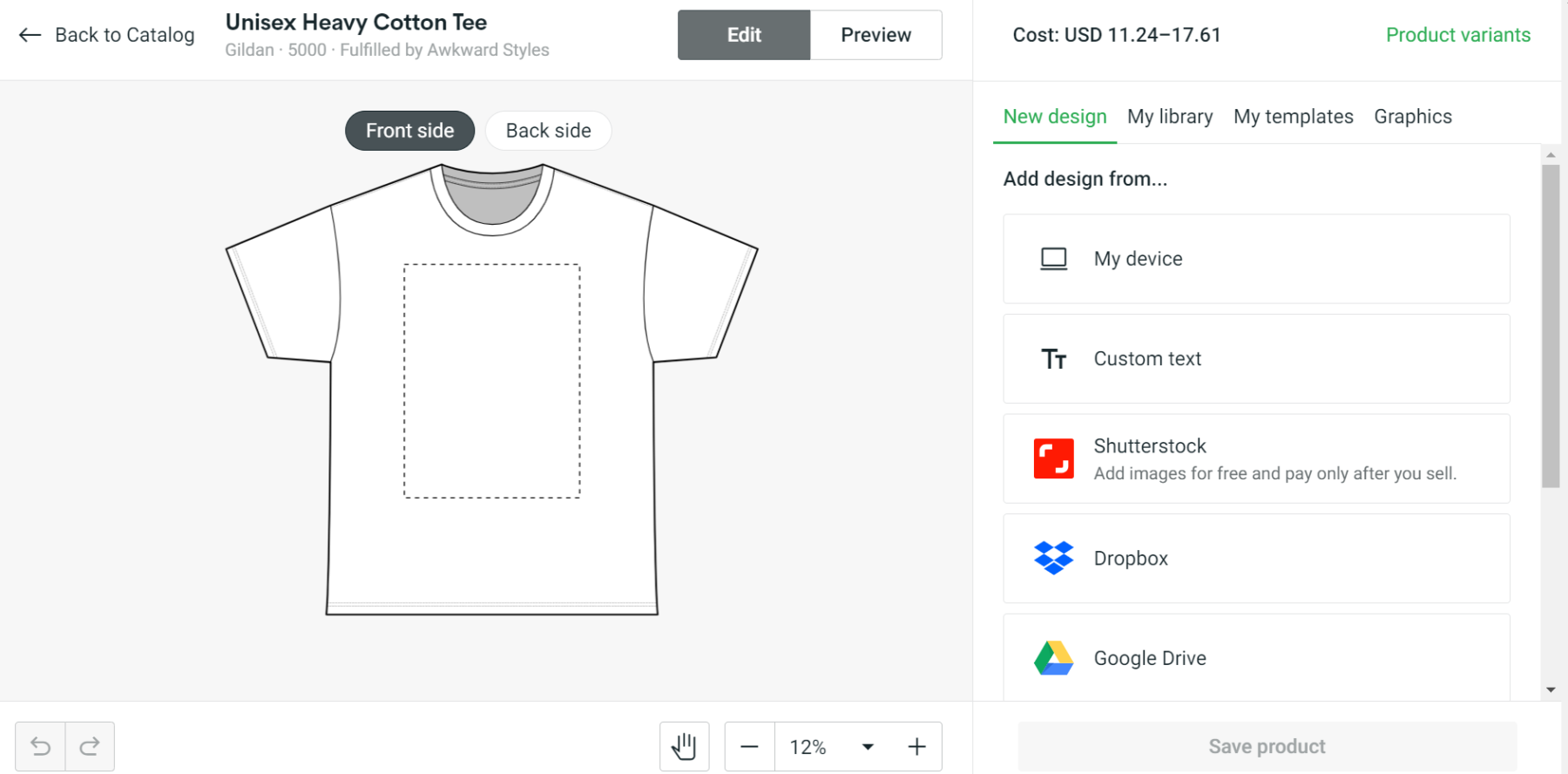
The above image is of a Printify T-shirt supplier; here, I can add images from my device, adjust it to a T-shirt, and that’s it. Now, they will print the t-shirt as soon as I get orders and ship that t-shirt to the respective address.
The plugin helps you choose your supplier to provide prints and ships to the customer. That’s why choosing a reliable partner who can fulfill your orders on time is essential.
Compare and research the suppliers to choose them wisely.
4. Promotion & Marketing
Now, your product has been listed, and the website is live.
It’s time for traffic, but you’ll be surprised since you won’t get any traffic or sales. Because the print-on-demand market is so saturated, we must reach out to target customers to make sales.
Following are some of the types of marketing –
1. Social Media Marketing
Social media is a great way to connect with your customers; most importantly, it’s free. You can create an account on different social media apps and reach out to your target customers.
Develop a social media strategy and work on it. Create relevant content for your target audience, generate traffic, and use offers to convert them into customers.
Editor’s Pick: 15 Social Media Facts for Small Businesses
2. Digital Marketing
Digital marketing is a new age marketing, where you can run ads all over the internet. For example, in Google Ads, you can pay to rank on keywords people search. Digital marketing is comparatively cheaper than traditional marketing.
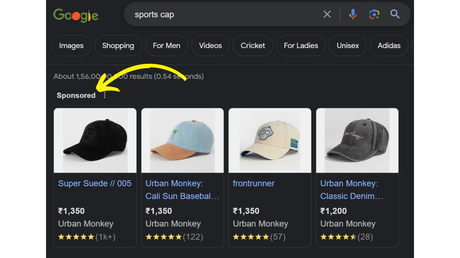
For example, here I have searched Sports Cap, and the first results I got are sponsored results. That means Urban Monkey (Sports cap company) has paid Google to rank on that keyword.
3. Influencer Marketing
Nowadays, Influencer marketing is becoming quite popular.
You can pay social media influencers and ask them to promote your products in their content. In this way, your product will reach their audience, and since they trust that influencer, there is a high chance that they will buy the product.
If you are low on budget, you can find someone with less than 10k followers. But most important is their audience should be your target customer.
4. SEO Marketing or Organic Marketing
It’s another free form of marketing.
For this, you need to know the basics of SEO and create SEO-optimized content to organically rank on Google.
That’s why it is also called content marketing.
Once your content starts ranking on Google, you will get traffic, and there is a high chance they will be your customers.
Read: 7 Elements of High Converting E-commerce Website
5. Stick to the Plan
Keep patience and stick to the plan.
It’s a process of learning and adapting; you might need to change your marketing strategies or product catalog. Be flexible and consistent; experiment with offers, suppliers, ads, etc. It will be a fun journey.
By doing this, you will not only earn profit but also learn e-commerce, sales and marketing, product designing, etc., high-value skills.
Tips to Make a Profitable Print-on-Demand Store
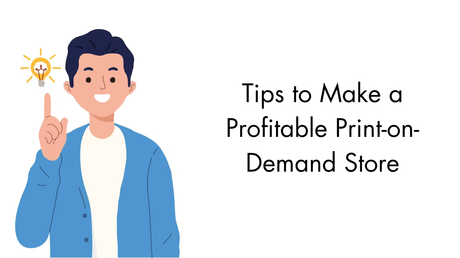
1. Order Samples
Since you haven’t seen your product in real life, you don’t know how it feels. Your sales pitch won’t have that intensity since you haven’t experienced the product firsthand.
That’s why you should always order samples and check their quality, material, print quality, etc. You will be able to market your product better.
For your information, some dropshipping companies even provide 20% discounts on samples, so utilize them.
2. Focus on Marketing
Having a good marketing strategy can be a game-changer for your business.
Devotee your time to develop a good marketing strategy, and you will soon be able to see its benefits.
The basic marketing is to know your target audience; for example, college-going girls are your target audience. Now, know your audience’s basic nature is that college-going students look for trendy products, but they are price sensitive.
They spend most of their time on social media, around college campuses & coaching classes.
A good marketing strategy can be knowing trendy designs and providing good discounts and flashy deals. You can put posters around college campuses and coaching classes, plus market yourself on social media.
For me, poster marketing will be the preferred marketing option, as not many businesses are doing poster marketing. So your business will quickly catch their attention.
3. Use Mock-ups to Show Your Products
Images are important; don’t post dull images, they will ruin all the efforts.
- Use mock-ups
- Do model photoshoot
- Capture attractive images of your product
- If possible, hire professionals
Comparison:
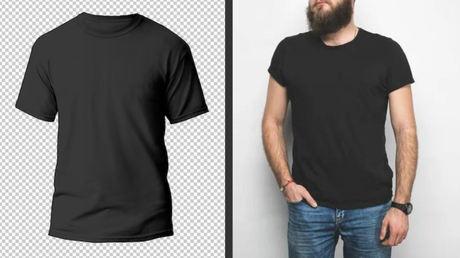
Even though both of them are plain T-shirts, the first one seems undesirable and less attractive.
4. Niche Marketing
On the internet, you are competing with local players and the whole internet. That’s why it is important to cut down competition; an easier way to do so is by choosing your domain where you can excel.
- It reduces your marketing efforts
- You know your audience and what they are going to like
- It is easier to be an expert in your niche
Research your niche and choose a profitable niche.
Final Words
It is great to see that you are starting a business and researching how to get things done. That’s a good start; it is safe to say you are in the right direction.
To make a business successful, you need to figure out how things work and how to make them work. It’s an exciting journey where you will learn a lot.
With a print-on-demand business, your ultimate goal is to make the first sale; once you make a first sale, you will know how to make a sale, and you can go on further to scale your business.
Hopefully, you have found this information relevant. You can read the FAQs if you have any questions.
Frequently Asked Questions
1. How much money can one make with a print-on-demand business?
It depends on three things – Average ticket value + profit margin + sales in a month. High ticket value with good sales and a good profit margin can increase your chances of making a good income and vice-versa.
2. How long does it take to make money with a print-on-demand business?
It has no clear answer; the print-on-demand market is too saturated. You need to keep experimenting and try to be different from competitors.
You need to thrive on making a sale; some people get their first sale in a week, while others need to wait a month to see the sale.
The idea is to be consistent with your efforts in the right direction.
3. What are the best print-on-demand products to sell?
Following are some of the best print-on-demand products to sell:
1. Tote Bags
2. Stickers
3. Hoodies
4. Bottles
5. Yoga pants
6. Wall Art
7. Backpacks
8. Waterbottles
9. T-shirts
4. Can I use Pinterest Designs or Etsy Designs on my products?
No, Pinterest designs or Etsy designs are intellectual properties. Which you can’t use without the permission of its creator. If you use such pictures, the artist can legally challenge you.
